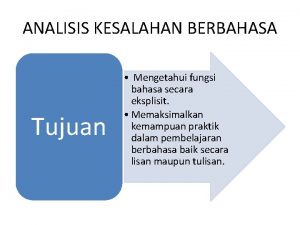Manifestations of attentional lapses in auditory evoked potentials

- Slides: 1

Manifestations of attentional lapses in auditory evoked potentials Lazarev I. E. , Chernyshev B. V. , Bryzgalov D. V. , Antonenko A. S. , Arkhipova E. A. , Khusyainova G. R. National Research University Higher School of Economics, Laboratory of Cognitive Psychophysiology, Moscow, Russia ilazarev@hse. ru Results, experiment 1 Introduction Here we try to address the question which ERP parameters may be identified as correlates of occasional spontaneous errors related to failures in information processing in alert non-clinical subjects. Tasks described in literature usually use distractors or competing tasks, which make participants distract their attention from the target stimuli (“induced” errors). The current study was designed to investigate spontaneous errors made by participants in the absence of any distractors or any overt competing tasks. Relying on the set of behavioral data (Dyson and Quinlan, 2003; Thompson, 1994), we can propose that the use of a condensation task, requiring overt behavioral responses and feature binding, seems to be well suited for the study of failures in purposeful responding. The condensation task apparently depends upon higher-order cognitive processes and mimics everyday purposeful human behaviour relying on recognition of various complex stimuli and choice of appropriate responses to them. Difference map (correct-error) ERPs 2 μV 0 -2 μV Materials and methods In experiment 1 data were obtained in 56 participants (mean age 20. 9± 1. 3 years). Participants were presented with four brief tones (40 ms, 85 d. B) which were randomly presented with equal probability. The stimuli could be discriminated by way of conjunction of two distinct features: pitch and noisiness (high pure, high noised, low pure and low noised sounds). Participants were asked to discriminate the stimuli and to respond by pushing one of two buttons. The stimuli used had well discernible differences in their physical parameters. Task performance required the conjunction of the two physical features, thus imposing a high load on attention (Treisman, Gelade, 1980). Each participant was recorded during 5 blocks of trials, each block consisted of 100 trials. Interstimulus interval was 2500 ms ± 500 ms. Evoked potentials were coherently averaged for each type of response. In experiment 2 condensation task was integrated into the oddball task. In addition to four stimuli described above, one sinusoidal stimulus serving as frequent standard was added (it was “pure” and 400 Hz with 40 ms duration, 10 ms rise and fall, sound pressure level was 95 d. B). Stimuli were presented with probability ratio 4: 1 (4 standards vs. any deviant tone combining two features). As in experiment 1 participants were asked to discriminate the stimuli and to respond by pushing one of the two buttons. Data were obtained in 48 participants. N 1 does not change, P 2 is bigger in case of errors, N 2 -P 3 are not pronounced, no differences found in their time windows For more details of experiment 1 results you are welcome to download the working paper at http: //www. hse. ru/data/2012/12/28/1304052706/06 PSY 2012. pdf Results, experiment 2 ERPs Difference map (correct-error) Table. Response contingencies in the experimental task: this table was read as well as handed in printed form to the participants immediately before the experiment. High Low Pure Noised Left button Right button Left button 2 μV 0 -2 μV Conclusion Since the participants had no problems in understanding the response rules, and they apparently had no problems in recognizing the stimuli, the behavioral lapses could be hypothetically explained by reallocation of the attentional resources to some covert activity such as mind-wandering (Smallwood et al. , 2008), which competed for the resources with the process of sensory information processing and decision making. The role of the P 2 component is not completely clear at the moment (Tong et al. , 2009). According to Melara (2002), P 2 reflects discontinuation of ignored information processing. We can speculate that enhanced P 2 is a reflection of some processes in auditory cortex which lead to premature (within 100 – 150 ms after stimuli onset) termination of signal information processing and consequently to failures in the behavioral response (this process may be similar to the “rejection positivity” described by Alho et al. , 1987). References N 1 remains the same, P 2 is slightly bigger in case of errors N 2 and P 3 remain the same The study was implemented in the framework of The Basic Research Program of the National Research University Higher School of Economics in 2014 Alho, K. , Tottola, K. , Reinikainen, K. , Sams, M. , Naatanen, R. , 1987. Brain mechanism of selective listening reflected by event-related potentials. Electroencephalogr. Clin. Neurophysiol. 68, 458– 470. Chernyshev B. V. , Lazarev I. E. , Ivanov M. V. , Osokina E. S. , Vyazovtseva A. A. Аttentional lapses under decision-making: an event-related potential study. Working paper. Series: psychology. WP BRP 06/PSY/2012. – Moscow: Higher School of Economics, 2012. URL: http: //www. hse. ru/data/2012/12/28/1304052706/06 PSY 2012. pdf Dyson, B. J. , Quinlan, P. T. , 2003. Feature and conjunction processing in the auditory modality. Percept. Psychophys. 65, 254– 272. Melara, R. D. , Rao, A. , Tong, Y. (2002). The duality of selection: excitatory and inhibitory processes in auditory selective attention. Journal of experimental psychology. Human perception and performance, 28(2), 279– 306. Smallwood J. , Beech E. M. , Schooler J. W. , Handy T. C. (2008). Going AWOL in the brain – mind wandering reduces cortical analysis of the task environment. Journal of Cognitive Neuroscience, 20(3), 458 -469. Thompson, W. F. , 1994. Sensitivity to combinations of musical parameters: Pitch with duration, and pitch pattern with durational pattern. Percept. Psychophys. 56, 363– 374. doi: 10. 3758/BF 03209770 Tong Y. , Melara R. D. , Rao A. (2009). P 2 enhancement from auditory discrimination training is associated with improved reaction times. Brain Research, 1297, 80– 88. Treisman, A. M. , Gelade, G. (1980), ‘A feature-integration theory of attention’, Cognitive psychology, vol. 12, pp. 97 -136.

